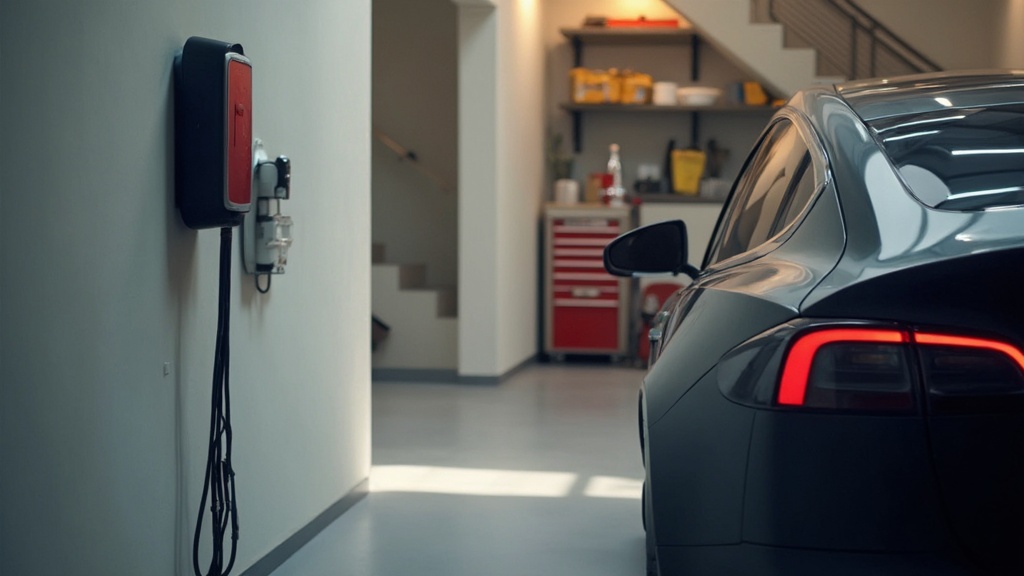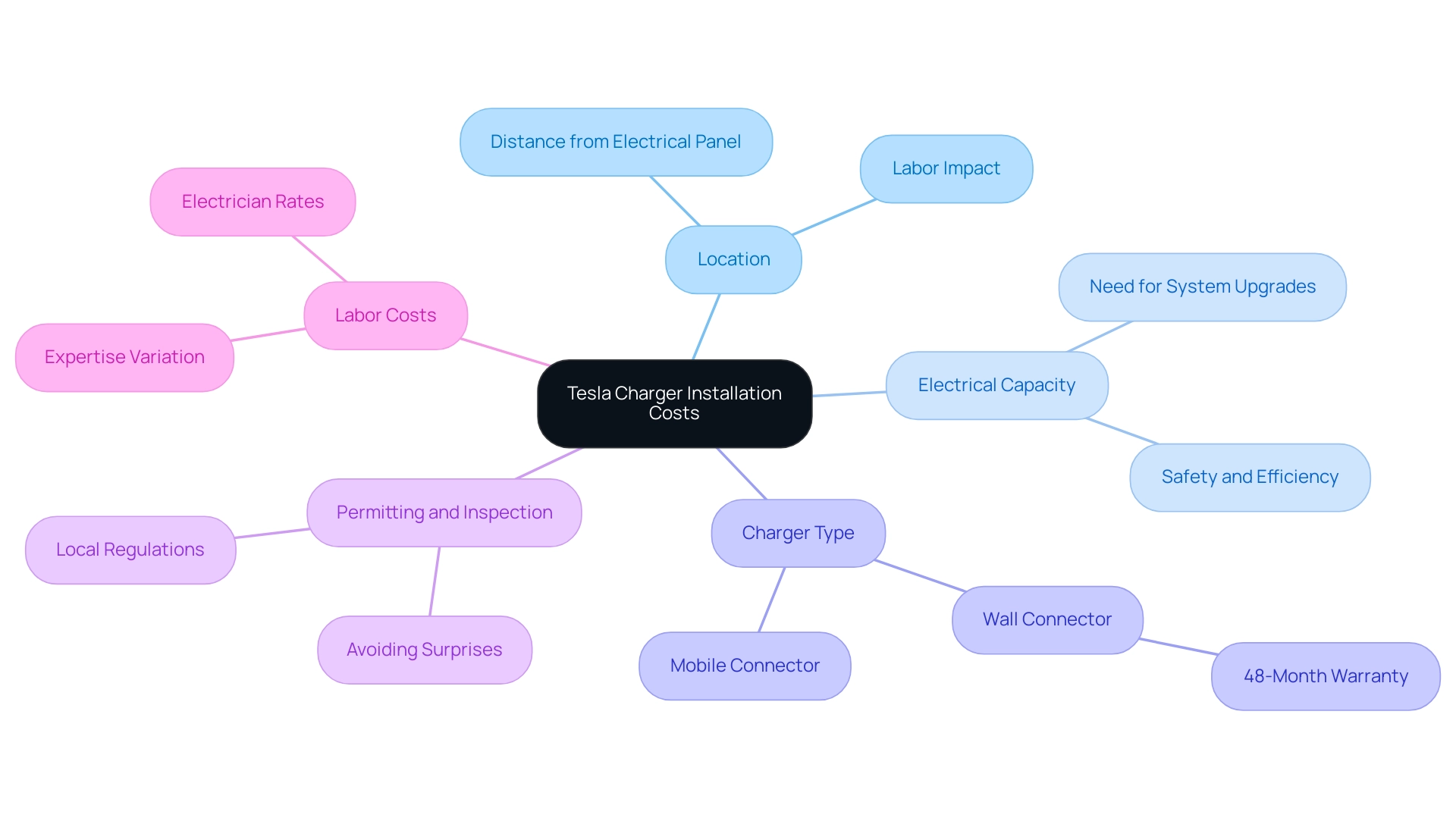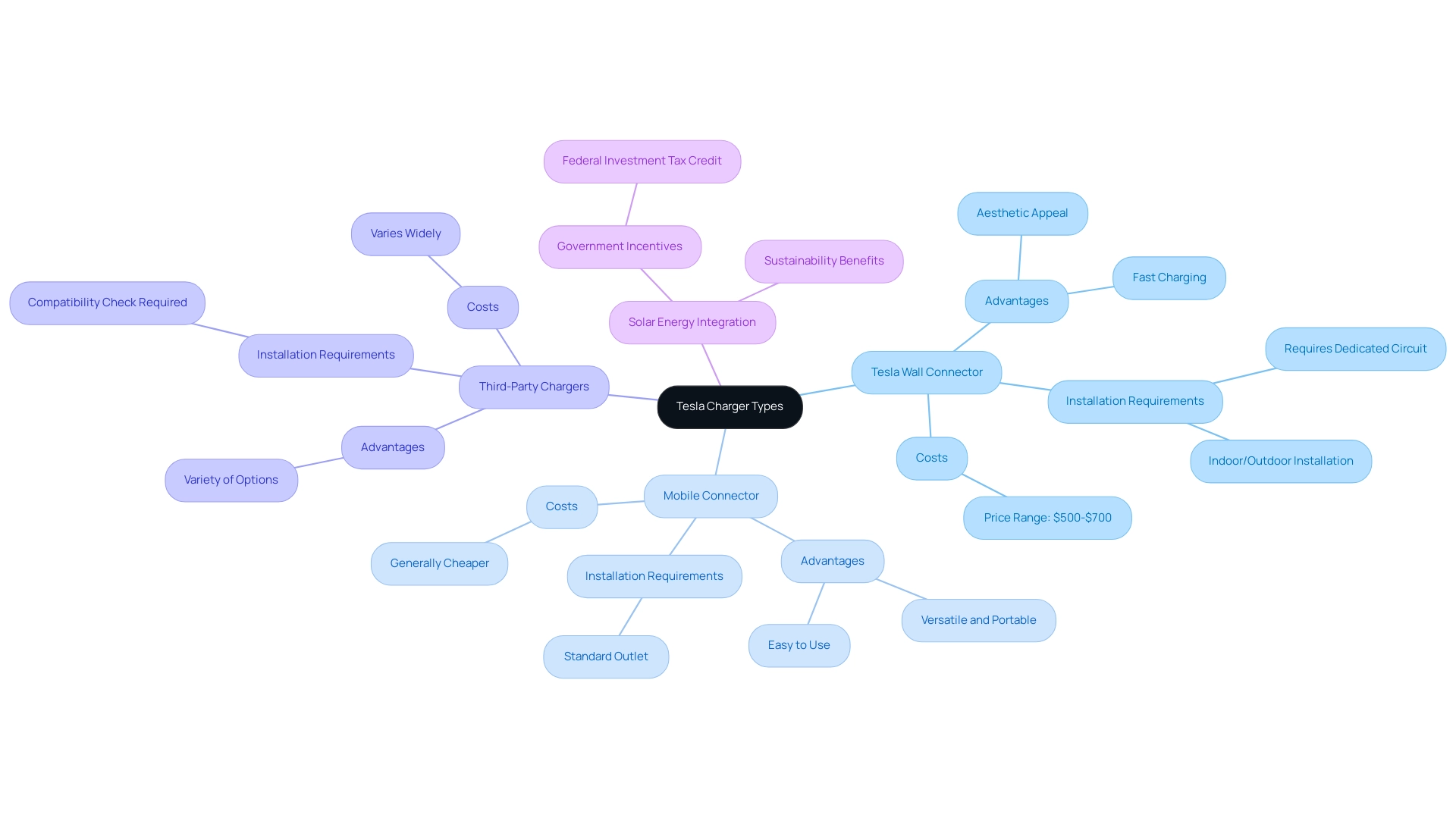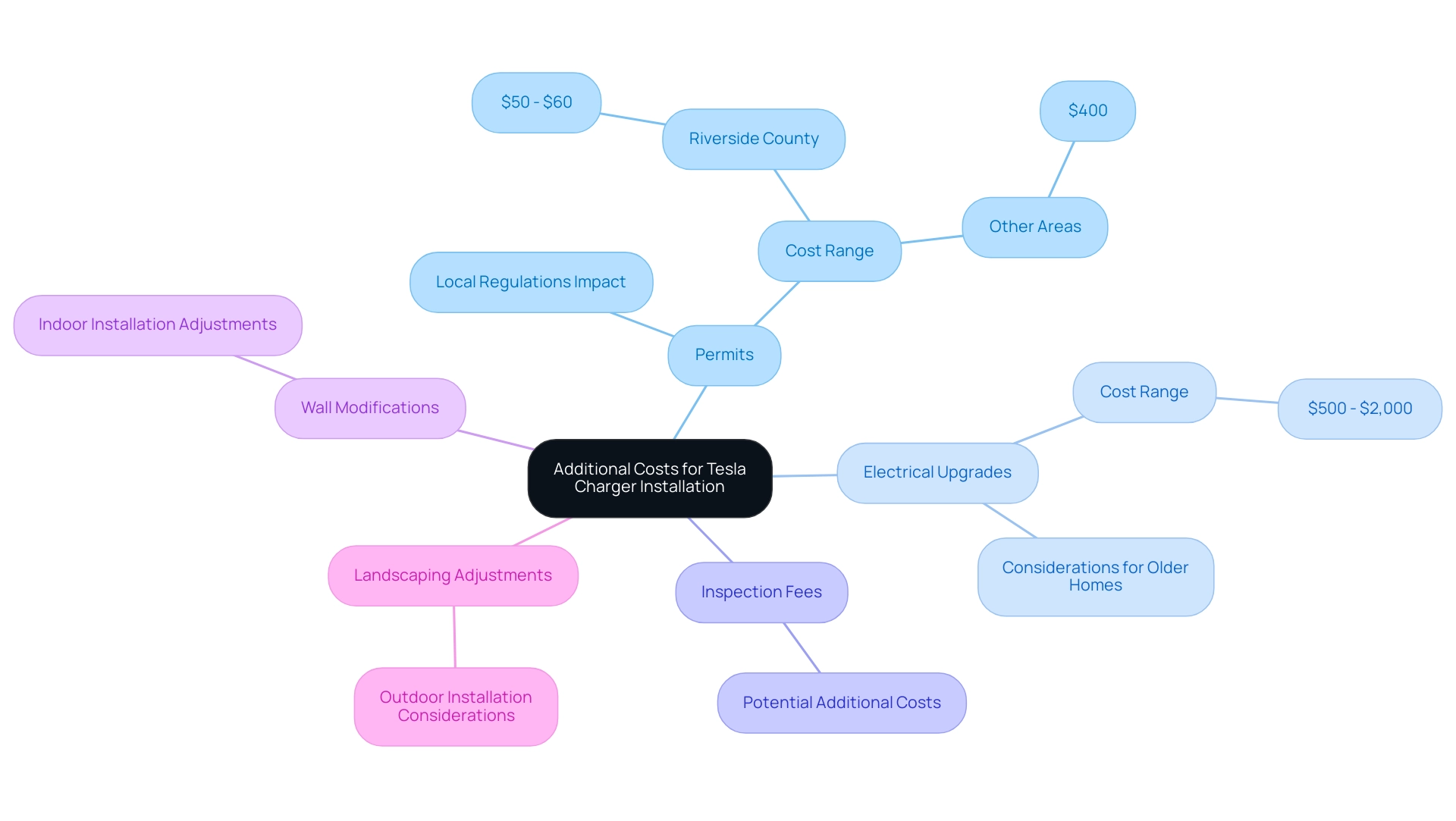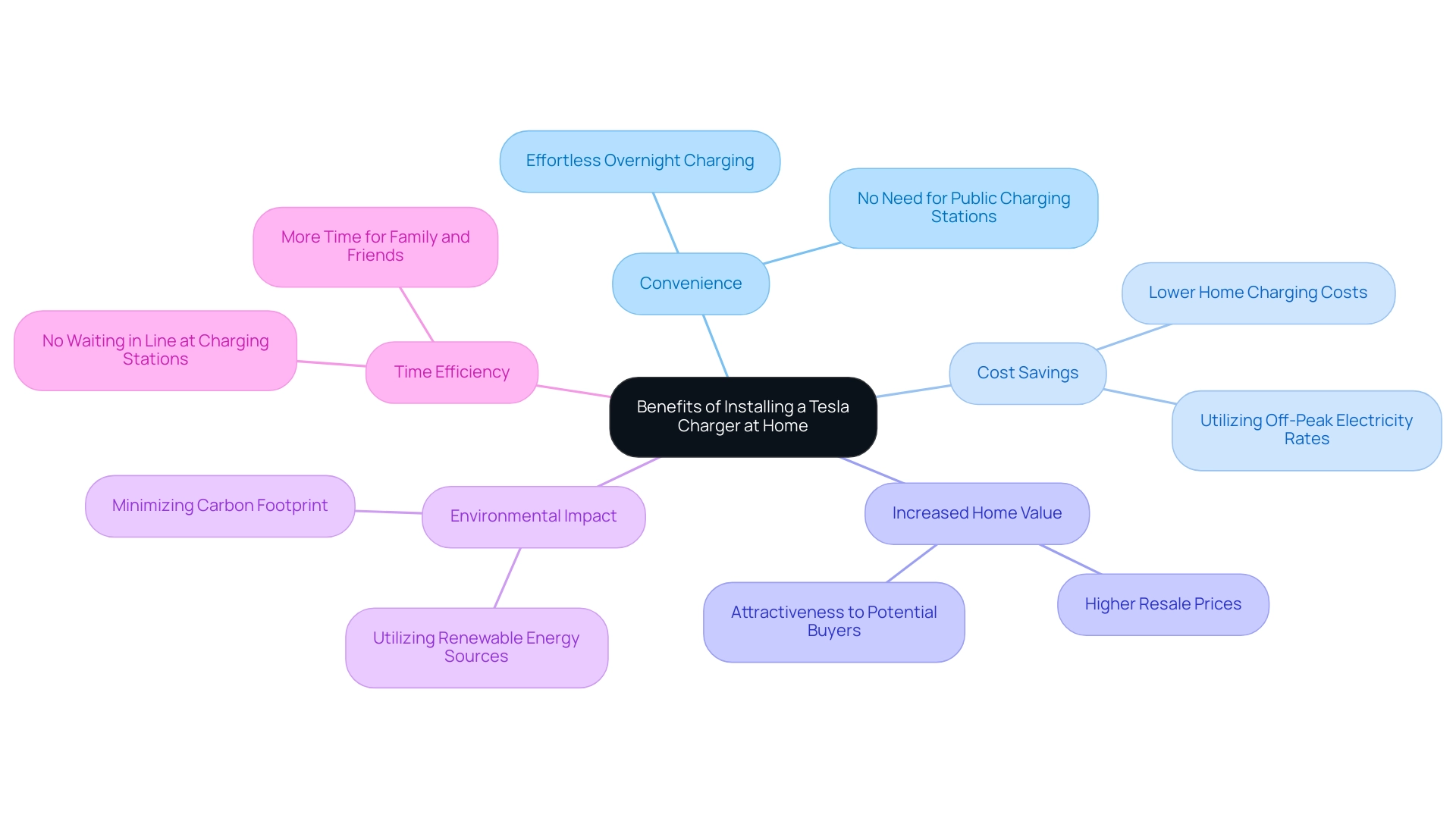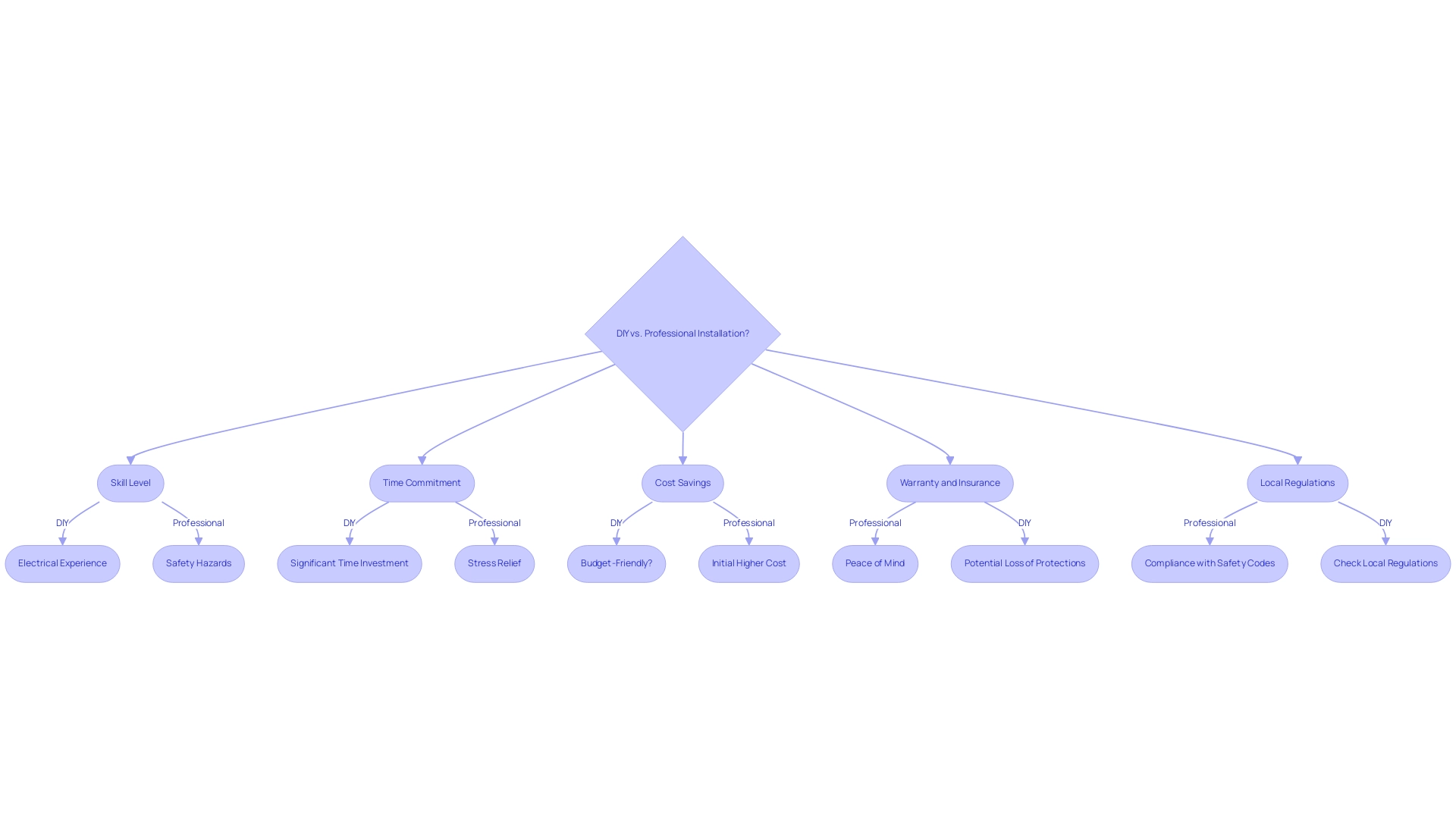Introduction
Installing a Tesla charger at home is more than just a practical upgrade; it’s a step towards embracing a sustainable lifestyle. For homeowners eager to tap into the benefits of electric vehicle ownership, understanding the various factors that influence installation costs is crucial.
- From the location of the electrical panel to the type of charger selected, each element plays a significant role in shaping the overall expense.
- Additionally, navigating the complexities of permits, inspections, and potential electrical upgrades can feel overwhelming.
However, with the right information and planning, homeowners can not only enjoy the convenience of charging at home but also enhance their property’s value and contribute positively to the environment. This guide will explore the essential considerations for installing a Tesla charger, helping homeowners make informed decisions that align with their eco-friendly goals.
Key Factors Influencing Tesla Charger Installation Costs
When contemplating how much it costs to get a Tesla charger installed at home, several key elements will influence the total expense, especially for environmentally aware homeowners seeking to take advantage of contemporary energy options. Let’s break them down:
- Location: The proximity of your electrical panel to the installation site can significantly impact labor costs. A charger positioned far from the panel may require additional wiring, increasing your expenses.
- Electrical Capacity: Homes with older electrical systems may need upgrades to handle the extra load from a Tesla charger. Although this can add to your total cost, it’s a crucial step for safety and efficiency, providing peace of mind as you transition to sustainable energy.
- Charger Type: Tesla offers various charging options, such as the Wall Connector and Mobile Connector. The setup complexity varies with the type you choose, influencing your final expenses. Notably, the Wall Connector comes with a warranty that covers it for 48 months, adding assurance to your investment.
- Permitting and Inspection: Local regulations may require permits and inspections, which can affect overall costs. It’s wise to check with your municipality to avoid surprises.
- Labor Costs: Electrician rates can vary widely based on your location and their expertise, which can substantially affect total setup costs.
In Alberta, for instance, AMPT Over Electric has built strong relationships since 2009, emphasizing integrity and respect. They provide extensive electrical setup services, including estimates, troubleshooting, safety inspections, circuit setups, and surge protection.
It’s advisable to arrange the setup of residential power equipment ahead of your vehicle delivery to ensure immediate power capability. As you prepare for your installation, keep in mind that the cost to get a Tesla charger installed is approximately $2,500, including labor, materials, and the station itself.
Moreover, factoring in the incorporation of solar energy can improve your sustainability initiatives. Government programs may also be available to assist homeowners in offsetting some of these costs. For instance, realizing that Level 1 power supply offers roughly 3 to 4 miles of range per hour might affect your selection of charger.
With the correct comprehension of these elements, including the advantages of solar panel operation and accessible governmental initiatives, you’ll be well on your path to enjoying the ease of electric vehicle refueling at your residence while making a positive impact on the environment!
Understanding Tesla Charger Types and Their Installation Requirements
When it involves powering your Tesla at your residence, you have several excellent choices available, each with its unique advantages and prerequisites. Recent discussions, such as the 539 replies in the Model Y: Battery & Charging thread, highlight the community’s engagement in exploring these options. Let’s break them down:
- Tesla Wall Connector: This is your go-to for fast and efficient residential charging. It requires a dedicated circuit, which means you’ll need a little electrical work done. As noted by Tesla experts, many recommend not using a 14-50 outlet unless absolutely necessary. The Wall Connector can be installed both indoors and outdoors, giving you flexibility based on your home layout. The setup procedure typically involves mounting the unit, running the necessary wiring, and connecting it to your electrical panel. While it may come at a higher price, typically ranging from $500 to $700 including installation, many people are curious about how much does it cost to get tesla charger installed, as they find its aesthetics appealing and the power-up speed well worth the investment. A case study titled “Charging Solution Recommendation” illustrates that while both the Mobile Connector and Wall Connector provide power at 32 A, the Wall Charger is often preferred for its aesthetic appeal and quicker power delivery capabilities.
- Mobile Connector: If you’re looking for versatility, the Mobile Connector is a solid choice. It plugs into a standard outlet, making it super easy to use, but keep in mind that it charges at a slower rate compared to the Wall Connector. Installation is generally a breeze—often just requiring a dedicated outlet. This option is excellent for those who may travel frequently or need a more portable solution.
- Third-Party Chargers: Some homeowners might explore third-party power options. These chargers can vary widely in their setup requirements, so it’s crucial to ensure they’re compatible with your Tesla. Always check for any specific needs or recommendations before making a purchase.
In addition, consider integrating solar energy solutions into your power system. With the government solar panel programs available, you might qualify for incentives that can lower the overall expense of your Tesla charging setup. For instance, programs like the Federal Investment Tax Credit can offer up to 26% off the cost of solar panel installation.
Plus, utilizing solar energy can significantly improve your residence’s sustainability profile. By understanding these charging options and considering how much it costs to get a Tesla charger installed, you’ll be better equipped to choose the one that fits your lifestyle, budget, and living arrangement. Whether you prioritize speed, convenience, or aesthetics, each solution has something to offer in a modern, eco-friendly garage setting.
Additional Costs to Consider When Installing a Tesla Charger
When planning to install a Tesla charging station at home, especially as an eco-conscious renter in Long Beach, it’s essential to keep in mind a few additional costs that might pop up along the way:
-
Permits: Most local jurisdictions require electrical permits for charger setups, and these can vary widely. In Riverside County, for example, a recent permit cost around $50 to $60, a far cry from the $400 that some have reported. It’s worth checking with your local authority to get an accurate figure for your area. This variability in permit costs can significantly impact how much does it cost to get a Tesla charger installed, particularly when considering local regulations and housing affordability.
Electrical Upgrades: If your residence’s electrical system isn’t up to snuff—say, needing a new panel or additional circuits—you could find yourself facing costs ranging from $500 to $2,000. This is a significant consideration, especially if your home is on the older side. Statistics show that the permitting process for a deck took significantly more hours for an inexperienced individual than it cost a contractor for a more complicated remodel, emphasizing the importance of hiring professionals.
-
Inspection Fees: After your device is installed, you may be required to have an inspection to ensure everything complies with local codes. This could add extra fees, so it’s a good idea to factor that into your budget.
-
Wall Modifications: Should you choose to install the device indoors, you might need to make some wall modifications or run conduits. These adjustments can also contribute to your total costs, so keep that in mind as well.
-
Landscaping Adjustments: If your device will be installed outdoors, you might need to tweak your landscaping or paving to accommodate the new setup, which could increase costs even further.
In essence, while the primary installation cost is crucial, it’s important to consider how much does it cost to get a Tesla charger installed, as these additional expenses can add up quickly. Moreover, integrating solar energy solutions can provide significant cost savings and environmental benefits when combined with your EV refueling setup. Government programs and incentives may also be available to help renters offset the costs of installing both solar panels and EV chargers, making the transition to eco-friendly energy even more accessible.
For those interested in learning more about EV power infrastructure and how it can complement solar energy solutions, consider joining us at the upcoming EV Power Summit and Expo. Planning ahead can save you from unexpected surprises and help you navigate both solar power and EV power options effectively!
Benefits of Installing a Tesla Charger at Home
Setting up a Tesla charging station at your residence offers numerous advantages that not only improve your driving experience but also positively affect your property value and the environment:
- Convenience: With a residential power source, you can effortlessly recharge your vehicle overnight, ensuring it’s fully powered and ready to hit the road each morning without the need for a trip to a public charging station.
- Cost Savings: When considering how much does it cost to get a Tesla charger installed, you’ll discover that powering your Tesla at home is usually more affordable than depending on public stations, especially if you use off-peak electricity rates. This means more savings in your pocket over time.
- Increased Home Value: A property equipped with an EV station is increasingly appealing to potential buyers. As electric vehicles gain popularity, residences with recharging options can experience considerable increases in resale worth. In fact, residences with EV chargers can command a higher price on the market, reflecting the growing demand for sustainable living solutions.
- Environmental Impact: By utilizing renewable energy sources, such as solar power, for your residential power requirements, you can further minimize your carbon footprint. This aligns with the global push towards sustainability and responsible energy consumption. Supporting this transition, Powercore Electric offers tailored solar solutions specifically designed for California communities, helping you to power your Tesla with clean energy and answer the question of how much does it cost to get a Tesla charger installed.
- Time Efficiency: Say goodbye to the inconvenience of waiting in line at power stations. Possessing a power source at your residence enables you to devote less time concerning yourself with your vehicle’s battery and more time enjoying life with family and friends.
Property owners have shared their positive experiences, mentioning that having a Tesla power station has not only simplified their lives but has also contributed to a more sustainable lifestyle, leading them to wonder how much does it cost to get a Tesla charger installed. One customer commented, ‘Since installing my Tesla power source, I no longer have to worry about power stations. It’s incredibly convenient!’
This quote highlights the benefits of residential power supply and its possible effect on energy usage. Furthermore, the EU and US are creating standards for megawatt-scale devices to support electric heavy-duty vehicles (HDVs), acknowledging the necessity for interoperability. This broader context of charging infrastructure development further illustrates the value of home electric vehicle stations, positioning homeowners to benefit from advancements in electric vehicle technology.
Embracing this technology today can position you at the forefront of this electrifying trend!
With Powercore Electric, you have a local partner committed to sustainable energy solutions, ensuring the highest quality craftsmanship and a personalized approach to meet your unique needs. Contact us today for your free, personalized estimate and take the first step towards a greener future!
DIY vs. Professional Installation: Making the Right Choice
When choosing between DIY and professional installation for your Tesla charger, you need to consider how much does it cost to get tesla charger installed.
- Skill Level: If you have previous electrical experience, you might be inclined to handle the setup yourself. However, it’s crucial to evaluate your skills realistically, as improper setup can pose safety hazards.
- According to safety statistics, DIY electrical work can lead to increased risks, making professional expertise invaluable. At Powercore Electric, we specialize in setting up EV charging stations, which includes a thorough site assessment to determine the best location and any necessary electrical upgrades to ensure safety and compliance with local regulations.
- Time Commitment: DIY projects can demand significant time and effort.
- If your schedule is already packed or you feel uncertain, hiring a professional can alleviate stress and save you precious time. Our team at Powercore Electric oversees the complete setup process, from site assessment to testing, enabling you to concentrate on what is most important.
- Cost Savings: While DIY projects can seem more budget-friendly, don’t forget to consider the expenses of essential tools and materials.
- Professional setups may have a higher initial price tag, but they often provide enhanced safety and adherence to local codes. With our expertise, you can be assured that your setup is done right the first time, avoiding costly mistakes.
- Warranty and Insurance: One advantage of choosing professional setup is the added peace of mind that comes with warranties and insurance.
- If you go the DIY route, you may forfeit these protections, which can be a significant downside. Our setups at Powercore Electric come with guarantees that protect your investment.
- Local Regulations: It’s essential to be aware of local regulations.
- Some jurisdictions require professional setups to ensure compliance with safety codes, so it’s wise to check before you start your project.
Nick Zamanov, head of sales and business development at Cyber Switching, emphasizes the significance of professional setup in promoting electric vehicle adoption, reflecting the future of EV infrastructure.
By weighing these factors carefully and considering the expertise offered by Powercore Electric, you can make an informed decision that aligns with your capabilities and needs. Contact us today to schedule your installation and ask how much does it cost to get tesla charger installed to ensure a safe and compliant setup!
Conclusion
Installing a Tesla charger at home represents not only a commitment to convenience but also a significant step towards a sustainable lifestyle. The journey to seamless electric vehicle ownership involves understanding various factors that influence installation costs, such as:
- Location
- Electrical capacity
- The type of charger chosen
By being informed about these aspects, homeowners can navigate the complexities of permits, inspections, and potential electrical upgrades with greater confidence.
The benefits of having a Tesla charger extend beyond mere convenience. From cost savings on charging to increasing property value, the advantages are compelling. Home charging eliminates the hassle of public stations and aligns with eco-friendly goals, especially when combined with solar energy solutions. This transition not only enhances daily living but also contributes positively to the environment, making it a worthwhile investment.
Whether opting for a DIY approach or hiring a professional, it’s essential to weigh all options carefully. Professional installation can offer peace of mind, ensuring safety and compliance with local regulations. Ultimately, embracing the shift to electric vehicle charging at home is a proactive step towards a greener future, one that benefits both individuals and the planet. With the right planning and resources, homeowners can enjoy the convenience of home charging while playing a part in the broader movement towards sustainability.


